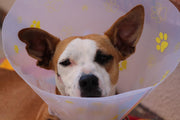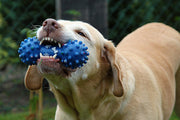
"What is this brown gunk?" When petting your dog and peeking into his ears, you should see clean, pink, and healthy-looking skin. However, if you notice dark-colored discharge, you may wonder what it means.
Dogs sometimes get messy, but their ears should remain clean and dry.
If your dog has brown discharge from his ears, it could mean different things. First, brown discharge is not a sign of a particular issue but rather a common symptom of several types of ear infections.
Common causes of dog ear discharges

Dog ear discharge is commonly clear. However, if you notice dark-colored wax or discharge, it may be the tell-sign of an ear infection.
Here are the common ear infections and how to identify them:
- Ear mites. Ear mite infections tend to affect puppies primarily. If you notice ground coffee-like residue in your dog's ear, your dog might have ear mites. Ear mites are contagious between animals but don't usually spread to humans. It's challenging to diagnose ear mites at home, but your veterinarian will take a closer look with his microscope to spot the tiny arachnids.
- Outer ear infection or otitis externa. If you notice a waxy, yellow, reddish-brown discharge, your dog may have an ear infection. Ear infections are often the result of allergies, mites, polyps, overproduction of ear wax, and excessive bathing or swimming.
- Inner ear infection or otitis interna. In addition to the previous symptoms, if your dog shows reluctance to open his mouth and shows balance problems, he may have an inner ear infection.
Infections may stem from a yeast infection or a bacteria infection.
Aside from looking at the residue and debris inside your dog's ears, here are some common symptoms of ear infections:
- Dog tilting his head left and right.
- Dog shaking his head.
- Dog scratching his ears.
- Dog rubbing his ears.
- Hot, smelly, waxy ears.
- Crusty, scabby, red, irritated ear skin.
If you suspect your dog has one of the infections mentioned above, consult your vet. Depending on the type of infection, he will recommend the most appropriate treatment.
How to prevent dog ear infections

Dog ear infections are not usually expected in dogs. However, some dogs may be prone to more frequent ear infections due to the size and shape of their ears. For example, long, floppy ears tend to cause more ear infections. This type of ear doesn't let the air flow as much and may trap humidity.
If your dog is prone to frequent ear infections, it might be because of allergies.
Boost your dog's immune system to prevent infections
When your dog has allergies, he may be prone to various infections and skin issues. This is because allergies weaken the immune system, which prevents your dog from naturally fighting off the infection before it develops into something more serious.
I have noticed over the years and confirmed with many other dog owners that a robust immune system would lead to fewer ear infections. However, you may wonder what the best way of boosting your dog's immune system is. I will show you three.
Get rid of food allergies.
Food allergies are pretty common among dogs and often go unnoticed because they are hard to diagnose. So I wrote an article on the most common food allergens. Contrary to popular belief, protein sources usually cause allergies, not wheat or grains. You can read the whole article here.
Add some salmon oil to your dog's food.
On top of the last option, you may want to add an extra boost to your dog's immune system. Many dog owners use fish oil daily, as Omega 3, 6 & 9 help boost the immune system and develop a healthy and shiny coat. If your dog scratches a lot, this will be very beneficial to him.
While you research fish oils, you will notice that some brands sell "fish" oil or "salmon oil." Always look for the fewest ingredients and the wildest and highest quality fish. For instance, choose Wild Alaskan Salmon over farmed salmon. Then, if the label reads "salmon," you know it is not wild.
We happen to sell our very own Wild Alaskan Salmon Oil Formula. So keep researching and if you think it is a good option for you, come back and buy it today.
Add some immune-boosting mushrooms.
Some varieties of mushrooms are highly beneficial to dogs' immune systems. They are natural sources of beta-glucans and polyphenols and will support your dog's life. Look for some famous mushroom names like Turkey Tail and look for a blend specifically made for dogs, and ideally, USDA Certified Organic.
While researching this product, you may stumble upon our Organic Mushroom Blend for dogs.
My dog's ear smells and has a brown discharge.

Smelly ears are not expected in dogs. However, if you notice a yeasty or stinky smell, your dog may have an ear infection. You can attempt cleaning your dog's ears at home, but if it is an infection, you should visit your veterinarian to take the appropriate steps to treat it.
Dog earwax color chart
What you see inside your dog's ears can help determine if they have an ear infection and which kind. However, it doesn't replace a vet's diagnosis. You may be wondering how does standard dog ear wax look?
Here are the standard discharge colors:
- No discharge. Your dog most likely does not have an ear infection. If your dog's skin is inflamed, it might be a sign of allergies.
- Black. If you wipe your dog's ears and notice coffee grounds-like residue, it might signify that your dog has ear mites.
- Dark brown. This color is often associated with yeast or bacterial infections.
- Brown. Light brown ear wax is standard and expected. Watch for other symptoms such as scratching or inflammation that could indicate an infection.
- Yellow. Another expected, normal color. Watch for other symptoms such as scratching or inflammation that could indicate an infection.
- Red. Red is not typically normal and could indicate the presence of blood. Consult your vet.
- Green. This color is often associated with yeast infections.
- Gray. Gray earwax could indicate dirt. Clean your dog's ears and see if the gray color returns, in which case it could indicate an ear infection.
How do you get brown gunk out and clean your dog's ears?

After noticing a brown discharge inside your dog's ears, you may want to know what is the best way to clean it.
I wrote a whole article on the subject here. I'll attach the main steps to clean your dog's ears below.
Before starting, you will need some supplies. Gather a dog ear-cleaning solution and cotton balls, and a towel.
You can follow these steps to clean your dog's ears:
- Clear your dog's ears when they are in a calm state. When grooming your dog, you can always use treats or toys to distract them.
- Fill your dog's ear canal with a veterinarian-approved ear-cleaning solution and massage the base of the ear for 30 seconds. You should hear a squishing sound as you do this. It's because the product is acting and dislodging debris and buildup.
- Let your dog shake his head. Use a towel or ear wipes to remove the excess liquid and clean your dog's ear.
- Use a cotton ball or gauze to wipe out the ear canal gently. Do not go deeper than one knuckle.
- If your dog seems in pain at any step of this process, stop visiting your veterinarian.
If you suspect a dog's ear infection, you should call your veterinarian. Dog ear infections may develop in the inner ear and outer ear. Keeping your dog's ears clean is essential for their health. Dirty dog ears may prevent your dog from hearing correctly and impede his balance. If you notice ear discharge, look at our color chart above to identify what is causing it.
Why are my dog's ears brown inside?

Sometimes, dogs develop ear infections. When this happens, the usually clear wax turns yellow to dark orange. If you notice a brown discharge, it may signify an infection in the inner ear or outer ear.
While it's easy to clean your dog's ear canal at home with the proper tools and supplies, your dog may require a veterinarian-approved treatment to get rid of the underlying infection.
Ear discharge in dogs: why you should talk to your vet?
Dark brown ear discharge is not customary in dogs. Usually, dog earwax is yellow to light brown. However, you should talk to your vet if you notice a different color and other ear infection symptoms such as scratching, inflammation, and your dog shaking his head.
Is brown ear wax standard in dogs?
Brown ear wax is standard in dogs. However, if the color is darker or completely different, it could signify an infection.
Can dogs get earaches?
Dogs can get ear infections such as ear mites, yeast, or bacterial infections. When their ear is infected, it may cause pain and disturb their balance. If your dog is constantly scratching his ears and shaking his head, he might be in pain, and you should consult a veterinarian.
What is earwax?

Earwax, or cerumen, is a naturally-occurring substance that develops in the external portion of the dog's ear canal. It is an oily substance and helps protect the ear canal from dust, debris, bacteria, dead cells, and other foreign elements.
How can I cure my dog's smelly ears?
If you notice your dog's ears are smelly, it might signify ear infections such as ear mites, yeast, or bacteria infections. The fastest way to cure your dog's smelly ears is to clean your dog's ears. However, if symptoms persist, then consult your veterinarian.
Why is my dog's ear always dirty?
Dogs ear should be pink, clean, and dry. If you notice discharge or debris, you may first attempt to clean your dog's ears with an ear-cleaning solution. However, if they become dirty again fast, it may signify an infection.
How can I tell if my dog has ear mites?

Mites are invisible to the naked eye, but they tend to leave a coffee grounds-like residue inside your dog's ears. A veterinarian will be able to properly diagnose them after scraping your dog's ears and looking under a microscope.
Tell me the symptoms of dog ear infections?
Common symptoms of dog ear infections are:
- Dog tilting his head left and right.
- Head shaking.
- Dog scratching his ears.
- Dog rubbing his ears.
- Hot, smelly, waxy ears.
- Crusty, scabby, red, irritated ear skin.
- Yeasty or stinky smell.
- Very waxy ear canal.
If you notice a brown discharge dog ear infection, it might signify that your dog has an outer ear infection.
How do you make homemade dog ear cleaner?
You can make a simple dog ear cleaner at home using a single ingredient: olive oil. Do not use Apple Cider Vinegar or Hydrogen Peroxide as they could irritate your dog's ears.
Drop a few drops of olive oil in your dog's ears, massage gently the base of their ear, and wipe out any excess with a cotton ball or gauze. It will allow the oil to dislodge debris in your dog's ear canal. In addition, it will help clean any ear discharge your dog has.
Please remember that this homemade dog ear cleaning solution is for healthy ears. If you suspect an ear infection, you should see a vet.




